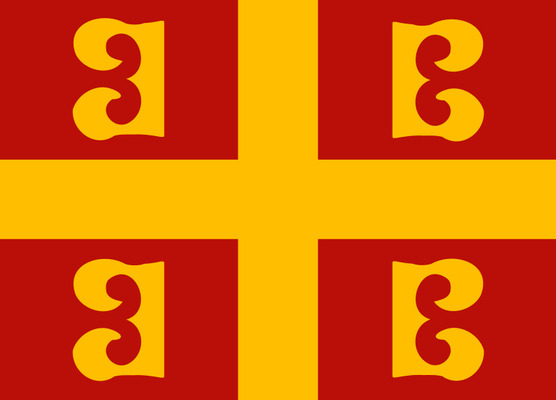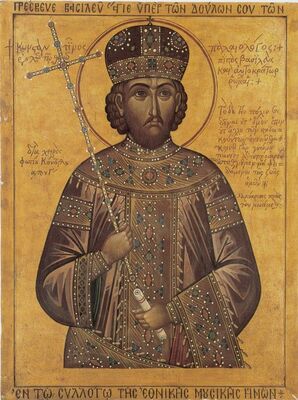Table of Contents

The emperor is elected by a majority vote of the senate & military, & thus hailed as Caesar. Usually, an emperor would appoint his hier as co-emperor, so this is only done when there is no emperor, or when someone seeks to usurp power.
The emperor is the living law (nómos émpsychos) & penultimate benefactor (euergétis), caretaker (philanthrōpía), & savior (sōtḗr) of his subjects (párœcos). The entire state & all that which is found in it is his “household” (œcuménē), & he is the “householder” (œconómos). His subjects are able to own land or industry, trade, & otherwise do anything else in the empire by virtue of their emperor’s authority. So, it’s impossible to e.g. bribe him, because he owns all of the currency—which bear either his name & face, or his father’s, &c.—and can take it at will.
The senate is seated by some thousand members, all of which are retired administrators and/or dignitaries. To be in the senate is to be, & have one’s relatives by extent be, noble—not plebian.
The empire is composed of dioceses (diœ́cēsis), which in turn are composed of provinces (eparchía/théma). Provinces are jurisdictions of & around cities, ruled by the govenor. The prefect—or duke, or captain—then rules over the govenors. Of course, the emperor rules over the prefects.
Many western states, such as Russia, were originally structured not unlike a lesser Roman principality, & so their princes or kings were never elected but rather, like the senate, followed the order & precedence of the noble houses.
Imperialty
| English | Slavic | Latin | Greek |
|---|---|---|---|
| Emperor | Tsar | Imperator | Aútocrátōr |
| Emperess | Tsaritsa | Imperatrix | Autocratórissa |
| King | K’nyas | Rex | Basileús |
| Queen | Knyaglinya | Regina | Basílissa |
| Lord | Gospod | Dominus | Cýrios |
| Lady | Gospoža | Domina | Cyría |
| Sebastus/Augustus | — | Augustus | Sebastós |
| Sebaste/Augusta | — | Augusta | Sebastḗ |
| Purple-born (son) | Tsarevič | — | Porphyrogénnētos |
| Purple-born (daughter) | Knyažna | — | Porphyrogénnētē |
The Sebastós & Sebastḗ were previously called at times the Aúgustos & Augústa.
Royalty
| English | Slavic | Latin | Greek |
|---|---|---|---|
| Master | Vladyka | Despótēs | |
| Mistress | Déspœna | ||
| Caesar | — | Cæsar | Cæ̂sar |
| Caesarina | — | Cæsárissa | |
| Most-noble | Nobilissimus | Nōbelíssimos | |
| Palace Curator | Cura Palatii | Curopalátēs | |
| Cup-bearer | Pinkérnēs | ||
| King (western) | — | — | Rēgas |
| Queen (western) | — | — | Rēgina |
Western kings were also sometimes just called ruler (archōn).
Dignities
| English | Slavic | Latin | Greek |
|---|---|---|---|
| President | Próedros | ||
| Magister | Mágistos | ||
| Vestarch | Bestárchēs | ||
| Vestes | Béstēs | ||
| Proconsul | Proconsul | Anthýpatos | |
| Patrician | Patrícios | ||
| Patricia | Patricía | ||
| First Swordbearer | Prōtospathários | ||
| Doorkeeper | Ostiáros | ||
| Chamberlain | Cubiculários | ||
| Swordbearer | Spathários | ||
| Consul | Consul | Hýpatos | |
| Groom | Strátōr | ||
| Silencer | Silentiários | ||
| Magister Militum | Stratēlátēs | ||
| Basin-bearer | Nipsistiários | ||
| Ruler (foreign) | Exusiastḗs |
Administration
| English | Slavic | Latin | Greek |
|---|---|---|---|
| Praetorian Prefect | Præfectus Prætorio | Hýparchos tō̂n Prætōríōn | |
| First Secretary | Prōtasēcrē̂tis | ||
| First Notary | Prōtonotários | ||
| Chancellor | Mesázōn | ||
| Prefect | Éparchos | ||
| Tribune | Triburnos | ||
| Pretor | Prǽtōr | ||
| Govenor | Cephalḗ | ||
| Ruler | Árchōn |
The Mesázōn was previously called the Logothétēs
Money
| Roman | Greek | Hebrew |
|---|---|---|
| Nymmus | Drachma | Shekel |
| Follis (40 Nymmi) | Mina (100 Drachmæ) | Mina (60 Shekels) |
| Solidus (16,800 Nymmi) | Talent (6,000 Drachmæ) | Talent (3,600 Shekels) |
| English |
|---|
| Penny |
| Shilling (12 Pence) |
| Sterling (240 Pence) |
Army
| English | Slavic | Latin | Greek |
|---|---|---|---|
| Exarch | Éxarchos | ||
| Grand Domestic | Mégas Domésticos | ||
| School Domestic | Domésticos tō̂n Scholō̂n | ||
| Provinicial Domestic | Domésticos tō̂n Thématos | ||
| Captain | Catepánō | ||
| General | Stratēgétēs | ||
| “Squadrarch” | Turmárchēs | ||
| First Groom | Prōtostrátōr | ||
| “Camp-ruler” | Stratopedárchēs | ||
| “Hoplitarch” | Hoplítárchēs | ||
| Centurian | Céntarchos | ||
| “Merarch” | Merárchēs | ||
| Brigadier | Taxíarchēs | ||
| Deputy | Topotērētḗs |
The Taxíarchēs was also called the Chilíarchēs.
Navy
| English | Slavic | Latin | Greek |
|---|---|---|---|
| Duke | Dúx | ||
| Admiral | Amirales | ||
| Drungary | Drungários | ||
| Count | Cómēs | ||
| “Navarch” | Naúarchos |
Dynasties

This list will begin with St. Constantine & his dynasty, but it should be understood his predecessor, Augustus, succeeded Cæsar, who in turn succeeded Alexander, who in turn succeeded Cyrus, who succeede Nabuchodonosor, who conquered Ægypt, & succeeded Nebrod, the first antediluvian king. All of the dynasties for those, in order, will be added later.
It needs be said here, according to Christians, Nebrod—who founded Babylon, Chaldæa, Accad, &c.—refused to take part in the building of the tower of Babel, & so fled westward to Syria, where he then founded Assyria & a number of other cities.
Click on each dynasty to go to its gallery.
- Constantinian
- St. Constantine the Great (†337)
- Constantius (†361)
- Jovian (†364)
- Valentinian
- Valentinian the Great (†364)
- Valens (†378)
- Gratian (†379)
- Valentinian (†392)
- Theodosian
- Theodosius the Great (†395)
- Arcadius (†408)
- Honorius (†423)
- St. Theodosius the Younger (†450)
- St. Plucheria (†450)
- St. Marcian (†457)
- Leonid
- St. Leo the Great (†474)
- Leo the Younger (†474)
- Zeno (†491)
- Basiliscus (†476)
- Anastasius Dicorus (†518)
- Justinian
- Justin the Thracian (†527)
- St. Justinian the Great (†565)
- Justin (†578)
- Tiberius Constantine (†582)
- Maurice (†602)
- Theodosius (†602)
- Phocas (†610)
- Heraclian
- Heraclius (†641)
- Heraclius Constantine (†641)
- Heraclonas (†641)
- Constans the Bearded (†668)
- St. Constantine the New (†685)
- Justinian the Slit-nosed (†711)
- Leontius (†698)
- Tiberius Apsimar (†705)
- Philippicus Bardanes (†713)
- Anastasius (†715)
- Theodosius (†717)
- Isaurian
- Leo the Isaurian (†741)
- Constantine Copronymus (†775)
- Artabasdus Iconophilus (†743)
- Leo the Khazar (†780)
- Constantine the Blinded (†797)
- Irene of Athens (†803)
- Nicephorian
- Nicephorus the Logothete (†811)
- Stavracius (†812)
- Michael Rangbe (†813)
- Leo the Armenian (†820)
- Phyrgian
- Michael the Stammerer (†829)
- Theophilus (†842)
- St. Theodora the Restorer of Orthodoxy (†855)
- Michael the Drunkard (†867)
- Macedonian
- Basil the Macedonian (†886)
- Leo the Wise (†912)
- Alexander (†913)
- Romanus Lecapenus (†948)
- Christopher Lecapenus (†931)
- Constantine Lecapenus (†948)
- Stephen Lecapenus (†963)
- Constantine the Purple-born (†959)
- Romanus II (†963)
- Nicephorus Phocas (†969)
- John Tzimisces (†976)
- Basil the Bulgar-slayer (†1025)
- Constantine VIII (†1028)
- Zoë the Purple-born (†1050)
- Romanus Argyrus (†1034)
- Michael the Paphlagonian (†1041)
- Michael the Caulker (†1042)
- Theodora the Purple-born (†1056)
- Constanine Monomachus (†1055)
- Michael Bringas the General (†1057)
- Isaac Comnenus (†1060)
- Dukid
- Constantine Ducas (†1067)
- Eudocia Macrembolitissa (†1067)
- Michael Ducas (†1090)
- Romanus Diogenes (†1072)
- Nicephorus Botaniates (†1081)
- Comnenian
- Alexius I Comnenus (†1118)
- John the Good (†1143)
- Manuel the Great (†1180)
- Alexius II Comnenus (†1183)
- Andronicus Comnenus (†1185)
- Angelian
- Isaac Angelus (†1204)
- Alexius III Angelus (†1211)
- Alexius IV Angelus (†1204)
- Alexius Angelus Murtzuphlus (†1204)
- Lascarian
- Theodore I Lascaris (†1222)
- St. John Batatzes (†1254)
- Theodore II Lascaris (†1258)
- John Lascaris (†1305)
- Palæologan
- Michael Palæologus (†1282)
- Andronicus Palæologus the Elder (†1332)
- Andronicus Palæologus the Younger (†1391)
- John V Palæologus (†1391)
- John Cantacuzenus (Josaphat in monasticism) (†1383)
- Andronicus IV Palæologus (†1385)
- John VII Palæologus (†1408)
- Manuel Palæologus (†1425)
- John VIII Palæologus (†1448)
- Constantine Dragases Palæologus (†1453)
- Rurikid
- Ivan the Great (†1505)
- Basil III (†1533)
- Ivan the Terrible (†1584)
- Feodor the Blessed (†1598)
- Irena (Alexandra in monasticism) (†1603)
- Boris Godunoff (†1605)
- Feodor Godunoff (†1605)
- Basil Šuisky (†1612)
- Romanoff
- Michael Romanoff (†1645)
- Alexis Romanoff (†1676)
- Feodor III Romanoff (†1682)
- Ivan V Romanoff (†1696)
- Peter I Romanoff (†1725)
- Catherine I Romanoff (†1727)
- Peter II Romanoff (†1730)
- Anna Romanoff (†1740)
- Ivan VI Antonovič (†1764)
- Elizabeth Romanoff (†1762)
- Peter III Romanoff (†1762)
- Catherine II Romanoff (†1796)
- Paul Romanoff (†1801)
- Alexander I Romanoff (†1825)
- Nicholas I Romanoff (†1855)
- Alexander II Romanoff (†1881)
- Alexander III Romanoff (†1894)
- St. Nicholas Romanoff the Passion-bearer (†1918)
Only the gentiles remember Julian the Apostate (363) as an emperor. Christians omit his name.
It needs be mentioned that Ivan the Terrible was not the first of Moscow to take the name emperor (tsar), but only the first explicitly crowned so. Ivan the Great took the name emperor when he married Sophia Palæologue—daughter of Thomas Palæologus, brother of Constantine Dragases Palæologus. A prior prince of Moscow, St. Vladimir the Great, married Anna, daughter of Romanus II. Thus, according to Christians, Moscow is the rightful heir to the mantle (chalmys) of St. Constantine. This is symbolized via the crown of Monomakh’, which was gifted to St. Vladimir Monomakh’ by Consantine Monomachus when the former married a relative of the latter. It was Basil III who was told “Two Romes have fallen. The third stands. And there will not be a fourth. No one will replace your Christian Empire!” by Philotheus of Pskov (†1542).
I should also add, the last place the Palæologian state ruled after the fall of Constantinople was a principality in Mangup, Chrimea—then called Theodoro & Gotthia. It was a remnant of the despotate of Trapezunt, which in turn was under a branch of the Comnenian dynasty. The last ruler of Trapezunt was St. David Comnenus (†1463). The last ruler of Theodoro was an Alexander Palæologus, son of an Isaac Palæologus (†1475).